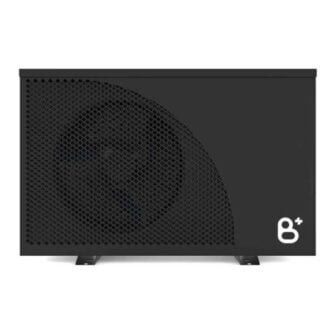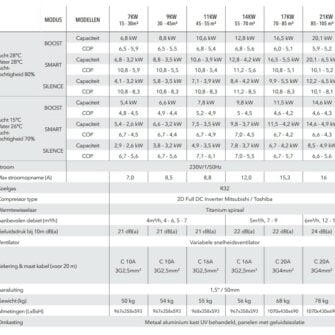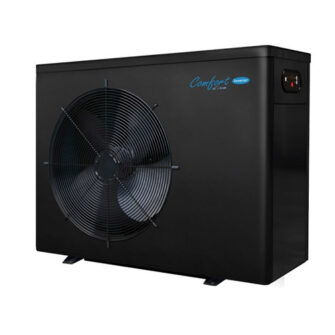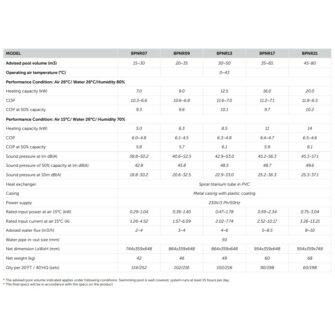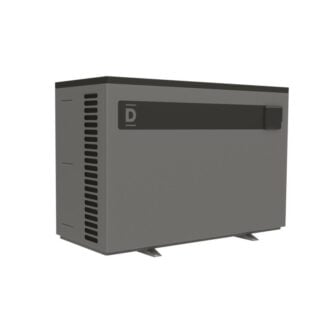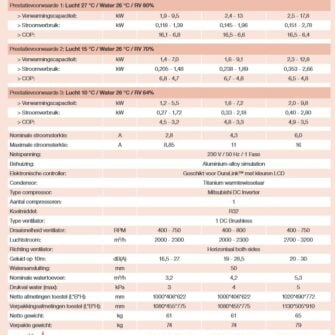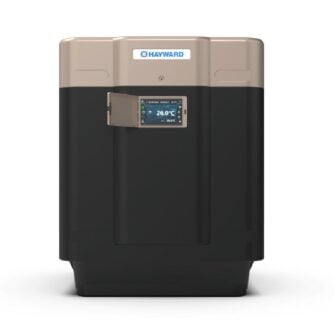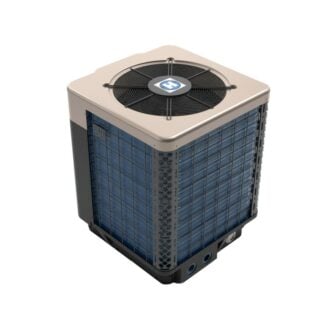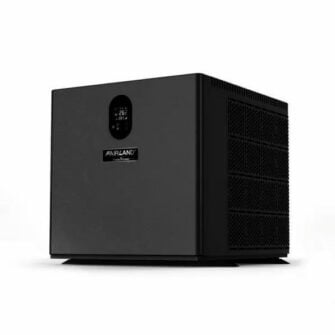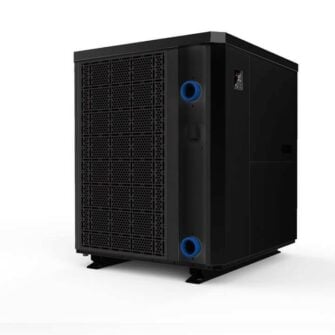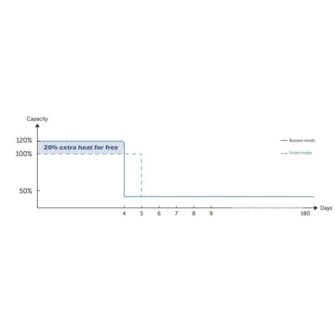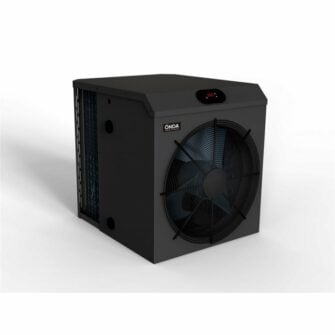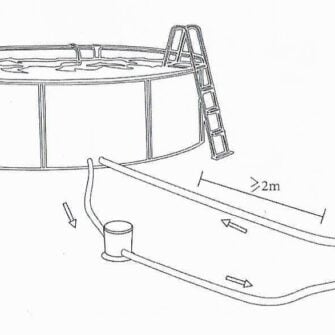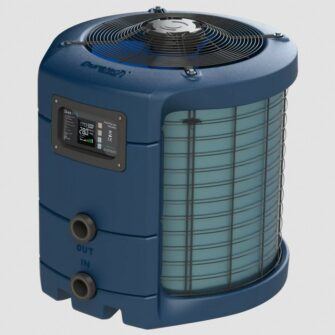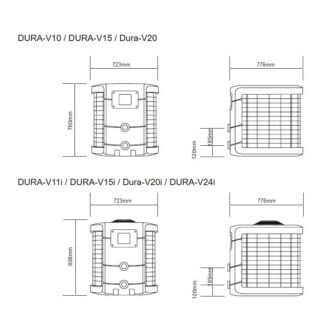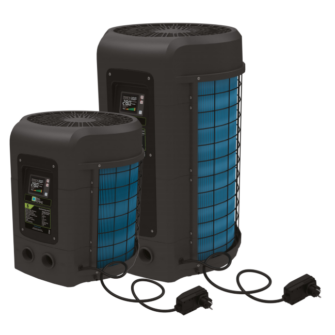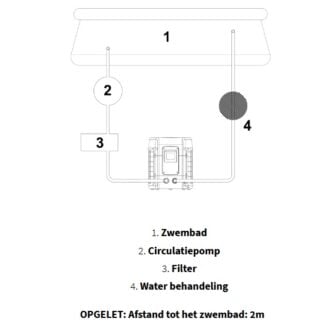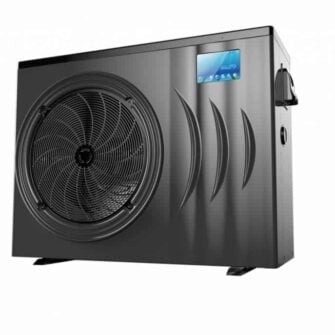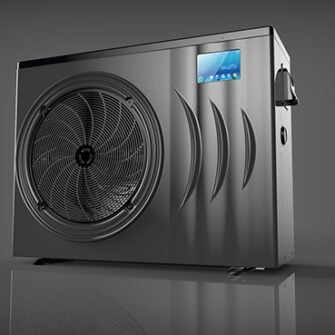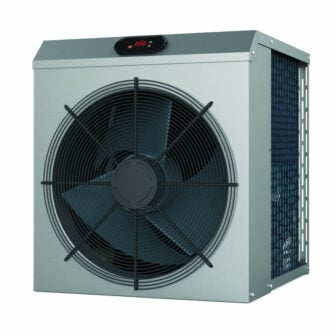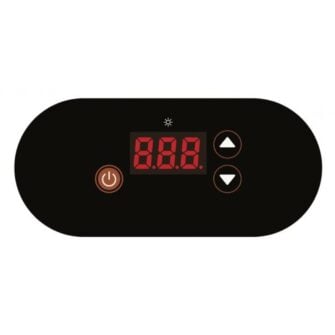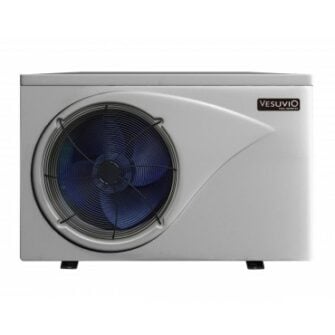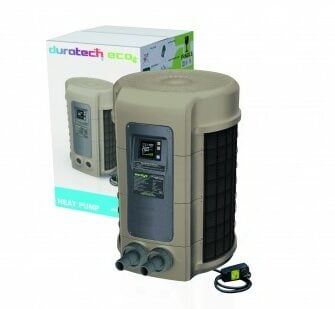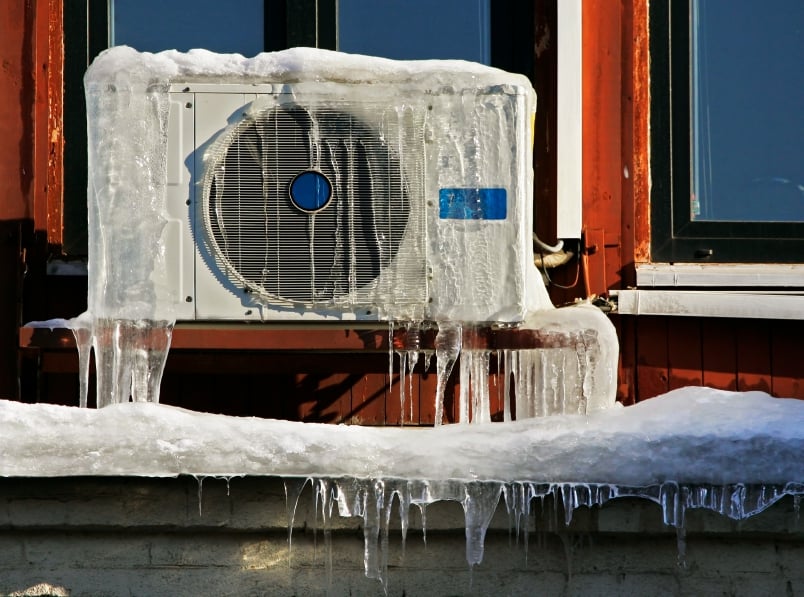Swimming in pool water with a pleasant temperature from April to September, it is possible with a heat pump for heating your swimming pool water. Below the different heat pumps for pool heating. At the bottom ALL INFO about SWIMMING POOL HEAT PUMPS
A swimming pool heat pump is the best choice for swimming pool heating.
If pool heating is a pool heat pump the very best choice (if you have solar panels). This heating for your swimming pool is economical, quiet and efficient. Compared to a conventional heat exchanger and heating boiler on oil or gas, this method is much more economical. The installation is also simple and completely independent of the heating of the house or pool house.
An overview of all information, advice and frequently asked questions about the swimming pool heat pump
- Is it normal that my heat pump should run 24/24 H?
- Do I have to switch a heat pump on/off manually each time?
- Is it necessary for the heat pump to be in the sun?
- What gas is in a swimming pool heat pump?
- Which electrical connection should I provide for my heat pump?
- What does the COP (efficiency) of the heat pump mean
- How much does a swimming pool heat pump consume?
- Which inverter heat pump should I choose for my swimming pool
- My heat pump is frozen, what should I do and why?
- How long can I swim with a heat pump?
- How fast will my pool heat up with a heat pump as pool heating?
- My pool water stops heating below the requested temperature
- Does the swimming pool heat pump have to be placed on a pedestal?
- Does a heat pump require a lot of maintenance?
- Is a heat pump easy to install?
- What types of heat pumps are there?
- My swimming pool heat pump is leaking, is it defective?
- Is a bypass necessary for the connection of my swimming pool heat pump?
- Does a heat pump make a lot of noise?
- How do I install a heat pump?
- How do you select the right swimming pool heat pump?
- Disadvantages of swimming pool heat pumps?
- What makes a swimming pool heat pump so great?
- Can I use a heat pump for any type of swimming pool?
- Should I choose a vertical or a horizontal heat pump?
- How do you protect the heat pump in winter?
Is it normal that my heat pump has to run 24/24 h?
A heat pump is a "slow - but economical" swimming pool heater. In concrete terms, this means that it will take quite some time before your swimming pool water has reached the desired temperature. Once the swimming pool water has reached the requested temperature, it will be sufficient to heat it up for a few hours a day.
How quickly does the swimming pool heat up with a heat pump?
The rate of heating up your pool approx 1°/ 4h in optimal conditions. Those are a good circulation : turnover of 4h, a minimum outside temperature : 15°C and a good cover for your swimming pool: a pool shutter and proper sizing: a 14kW inverter heat pump for 50m³.
The rate of heating depends on:
- the outside temperature is at least 15°C
- the night temperature is at least 15°C
- the number of hours your pump works 24/24h
- a built-up swimming pool or built-in swimming pool
- the extent to which you cover it well will determine how long this will take
So it is important to use the heat pump first let it work 24/7 for 3 - 7 days and then reduce the number of hours the pump runs. It is therefore important to exercise patience at the start-up. In contrast to heating on gas or heating oil via a heat exchanger where it is warm in 1 - 2 - 3 and goes much faster, but of course much less energy efficient.
Do I have to switch the heat pump on/off manually each time?
It is not necessary to turn the heat pump on and off during use. The heat pump for your swimming pool contains a flow switch (control system to detect water flow). This ensures that the pump will start when the requested temperature is higher than the temperature of the swimming pool water.
Is it necessary for the heat pump to be in the sun?
It is a common misconception that a heat pump works better if it is installed in the sun. The heat pump extracts the heat from the ambient air. Strictly speaking it is not necessary. There may be a very small benefit if you install the heat pump in a "warm corner" where there is always sun. However, the benefit of this is minimal. On the other hand, it is very important that there is very good circulation of the air.
What gas is in a heat pump?
A heat pump contains gas. Just like in an air conditioner or in a refrigerator, a swimming pool heat pump contains GAS. This gas ensures the exchange of heat between the air and the swimming pool water via the compressor in the pump.
INSTALLATION TIPS SWIMMING POOL HEAT PUMP :
- Care for a good suction of fresh air : install 80 - 100cm away from the wall
- Keep the space for the heat pump clear about 2 to 3 meters from the cold air can be blown away properly become
- If you have a vertical heat pump, make sure that there is no roof above the pump that will also affect the heat cold air can escape
- Place the heat pump as close as possible to the filter installation so as not to lose the heat on the way back
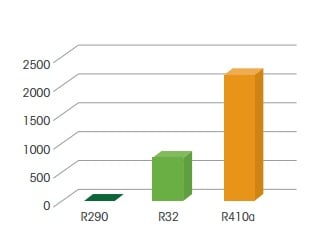
R23 gas better for the environment and performance
R32 gas replaces the well-known R410A refrigerant. The properties of these 2 gases are similar. R32 slightly improves efficiency; 5 - 7%.
Advantages of the R32 gas
- No influence on the ozone layer and therefore better for the environment
- 5 - 7% better efficiency
- Less gas required in the cooling circuit for the same output (20 - 30% less liquid)
- Pure liquid, easy to recycle
Which electrical connection should I provide for my heat pump?
It is best to provide for your heat pump an electric cable with the correct cable section. This is quite heavy considering the electrical consumption. Avoid problems with the electrical connection by installing the correct electrical cable. Below is an overview of the cables.
| Number of kw | 11 kw | 14kw | 17kw | 21kw | 27kw | 32kw |
| Fuse A | 10A | 10A | 16A | 16A | 20A | 26A |
| Power wire mm² | 3x2.5mm² | 3x4.0mm² | 3x4.0mm² | 3x6.0mm² | 3x10mm² | 3x10mm² |
The information is indicative, you should consult an authorized installer to correctly connect the device for your swimming pool installation.
What does the COP (efficiency) of the heat pump mean?
The COP (Coefficient of performance) is the efficiency generated by the heat pump for your pool.
- An ON/OFF model has a COP of around 5 = 1kW in --> 5kW output
- An inverter heat pump has a COP of around 10 = 1kW in --> 10kW output
These efficiencies are determined in official test setups. The efficiency depends on the ambient temperature. The warmer the air, the higher the efficiency. And this COP value is also determined by the temperature of the water in the swimming pool.
Below you can find a clear graphic display see the difference in heating between an ON/OFF heat pump for swimming pools and an Inverter type swimming pool heat pump.
Usually the heat pumps are advised on the basis of the volume it can heat. Manufacturers state a minimum volume and a maximum volume.
In fact, you can place a very heavy heat pump on a very small volume of pool water. The consumption is higher, the time to heat it up is shorter. So with an oversized heat pump you will be able to heat up the swimming pool water more comfortably. If you opt for an under-dimensioned heat pump, you will have to heat up for longer and this will therefore be slower.

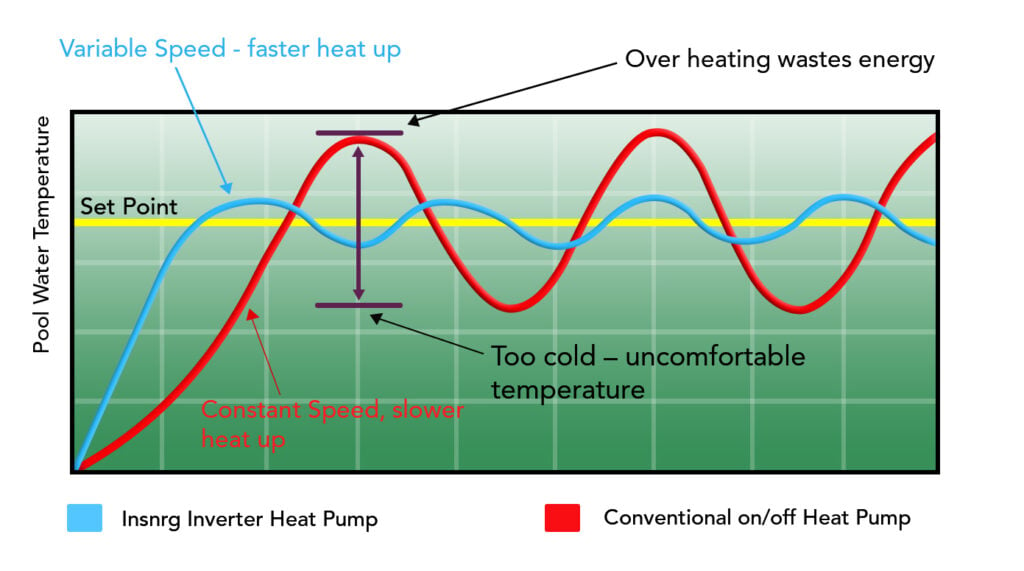
How much does a swimming pool heat pump consume?
A heat pump uses electricity. Consumption depends on the COP (efficiency - Coefficient of performance) of the heating.
- The conventional heat pumps have a COP of around 5: so the consumption is 1kw, while the output is 5kw.
- The new Inverter swimming pool heat pump has a COP of around 12 (sometimes up to 15): the consumption is therefore 1 kw and the output 12 kw. The inverter heat pump is therefore 50 - 70% more economical than an ON/OFF heat pump.
The consumption of a frequency-controlled heat pump is usually low on an annual basis between €480 and €750 for 50m³. This difference depends on the circumstances; temperature, humidity, heat loss, ...
READING TIP : Very energy-efficient swimming pool with these 10 TOP tips
Which inverter heat pump should I choose for my swimming pool
- 8kW 15 - 30m³
- 12kW 25 - 50m³
- 14kW 45 - 70m³
- 17kW 70 - 85m³
- 21kW 85 - 105m³
You can get a complete overview of our heat pumps found in the online store or you can visit us swimming pool store in Waregem.
Winter pool heating
The swimming pool heat pump works with refrigerant, a compressor and temperature exchange via a titanium heat exchanger. When the R32 liquid expands to gas, cold is developed. At the start of the season, this can cause a temperature just below freezing. As a result, condensation and moisture in the air will freeze. This is not a defect. Most heat pumps have a safety feature that activates a defrost cycle. After a while the ice will melt and the heat pump will heat up the pool water again.

How long can I swim with a heat pump?
With a good pool heating you can extend the period that you can enjoy the pool. With a heat pump for your swimming pool, you can swim in 28°C pool water from April to October. During the summer you will have to heat very little. In the spring and autumn, on the other hand, yes. We usually start up the swimming pools during the Easter holidays and close them during the autumn holidays. To keep the swimming pool water at 28°C in the spring and autumn, it is best to size the swimming pool heat pump well. Here are some tips to enjoy warm swimming pool water for longer:
- Cover the pool with a sail, a summer sail or a (solar) roller shutter
- Insulate the pool to keep the heat in the pool
- Place the filter installation as close as possible near the pool to minimize heat losses as much as possible
- Insulate the pipes to and from the pool
- Run the heat pump continuously, a heat pump works slowly and with small temperature differences. Constant operation is therefore crucial.
How fast will my pool heat up with a heat pump as pool heating?
With a circulation of 1 times the volume/4h, it is best to calculate with 1°C / 4h in optimal conditions
The rate of heating depends on your pool water depends on:
- The outside temperature, recommended is the temperature outside 15°C
- The humidity
- The insulation of your pool
- A solar cover or a standard tarpaulin will make a difference in warming up the pool
My pool water stops heating below the requested temperature.
For example, if you request 25°C from your heat pump, but it stops at 23°C, why is this?
- The heat pump can only run if there is circulation, no circulation --> no further heating. You can solve this by setting the circulation pump to "Manual". In this mode, the pump works day and night and the heat pump will therefore be able to work 24 hours and heat up the swimming pool water.
- Does the swimming pool heat pump run independently or is it also linked to a central system? Make sure that the desired temperature is also set correctly on your central system. Otherwise it will remove the voltage to the heat pump at eg 23°C instead of 25°C
Does the swimming pool heat pump have to be placed on a pedestal?
It is best to place a heat pump on a concrete base. There is a fan in the heat pump. This fan causes vibrations. This makes it necessary to place it on a pedestal. Place rubber blocks under the feet of the pool heater. These rubber blocks are supplied with the pump.
Around the concrete plinth can you get one water permeable finish provided such as pebble stones, grass or eg tree bark. A heat pump releases condensation water. This can be quite a lot at the start of the swimming pool.
Does a heat pump require a lot of maintenance?
A swimming pool heat pump is a costly device. Repairs are usually cumbersome and expensive. Proper maintenance of your swimming pool heating is therefore recommended.
- Your heat pump can do you best in winter to protect of a cover. With the more expensive models, this cover is included with the pump.
- In winter you should empty the heat pump. After all, water in the pump can freeze and damage the pump inside. TIP : TILT the pump slightly after emptying to allow the remaining water to run out
- After the winter it is best to give the pump a thorough cleaning give with our heat pump cleaner.
Is a heat pump easy to install?
==> One heat pump for a swimming pool under construction, intex pool or a plunge pool is usually a Plug & Play system. These are the properties:
- Light weight up to 40kg
- Easy to install
- Includes safety plug
- Connections included
- For smaller pools and aboveground pools.
- For swimming pools from 7 - 25m³
==> One common heat pump for larger swimming pools and built-in pools it is best to leave it installed by a swimming pool technician. These pumps come with coupling pieces, but these must be connected to PVC pressure pipes D50 or D63. The coupling pieces are included. The electrical cable must be routed separately from the fuse box to the heat pump and fused separately.
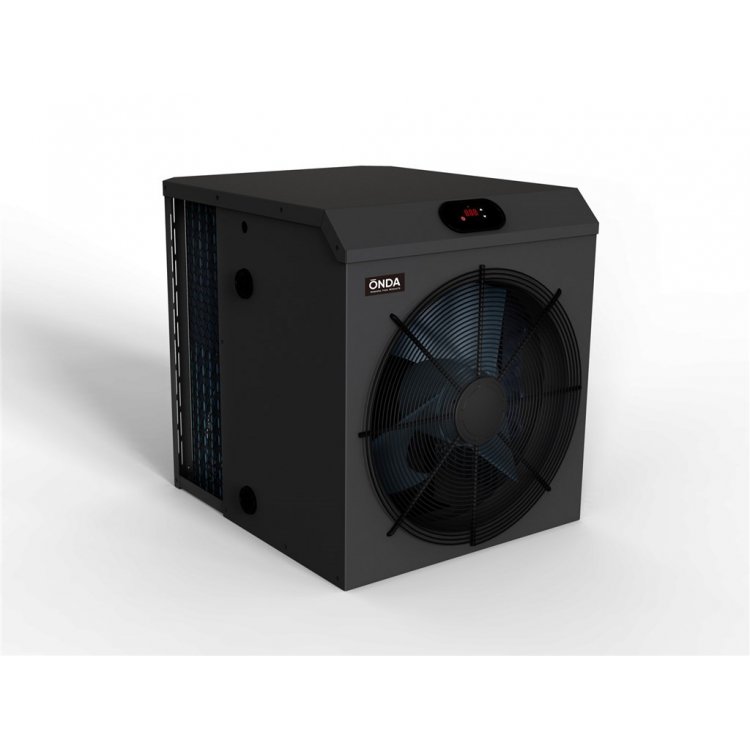
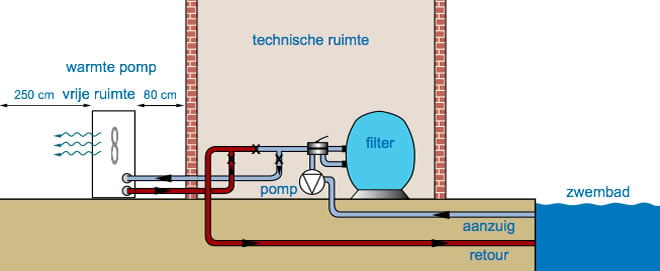
What types of heat pumps are there?
There are different types of heat pumps.
- the AIR/AIR heat pump
- An AIR/WATER heat pump
- finally the WATER/WATER heat pump
The air/water heat pump is most suitable for heating a swimming pool. The swimming pool water flows through the filter installation and this purified swimming pool water passes through the heat exchanger inside the air/water heat pump. Simply explained, the fan will suck in warm air, and this heat will be released to the swimming pool water via the cooling package. This warmer water flows back to the pool. The cold air is blown away. The most common heat pumps are horizontal models. The air therefore comes out of the heat pump at the front. An alternative model is a vertical heat pump. This will blow out the cold air at the top.
My pool heat pump is leaking!? Is she defective?
A common question is why the heat pump for the swimming pool is leaking? When exchanging the heat from the air to the water of the pool, there is condensation water generated. Due to the temperature differences, the pump will therefore release condensation water. So this is not a leak in the heat pump. The condensation can rise to 10L at start-up! It is advisable to provide water-permeable material around the concrete plinth where the heat pump is installed. This can be, for example, pebbles, grass or, for example, tree bark. Most pumps also have a drip tray and a nipple to drain the condensed water.
TIP : you can easily test whether the water on the heat pump is caused by condensation or a leak by checking the water with a test strip. If there is no chlorine in this water, then this is condensation water.
Is a bypass necessary for the connection of my swimming pool heat pump?
10 years ago this was always necessary to install a bypass. Nowadays, the full flow rates of pool filter pumps pumped by the heat pump. It is still advisable to provide a bypass.
- This makes uncoupling during the winter a lot easier.
- In this way you can also perfectly control the flow rate through the heat pump.
- The installation can continue to operate before replacement or during a defect.
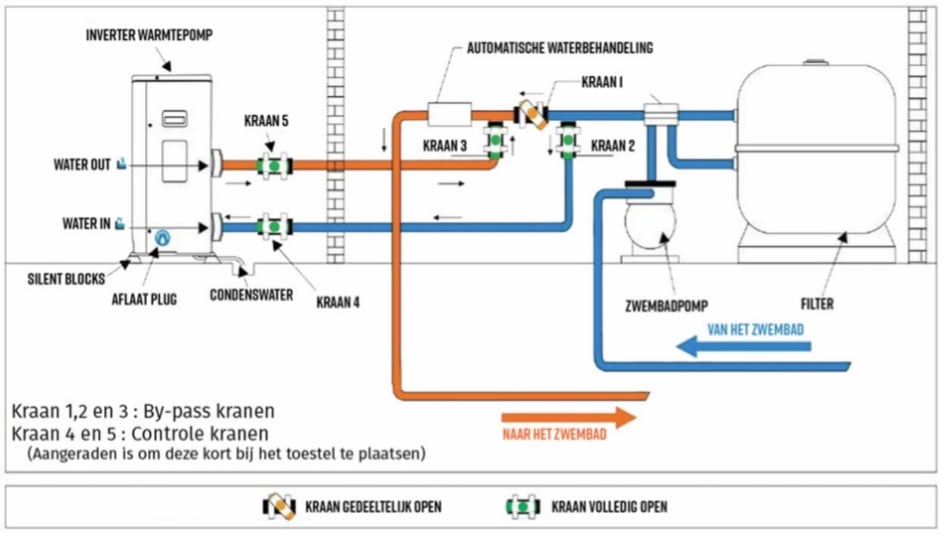
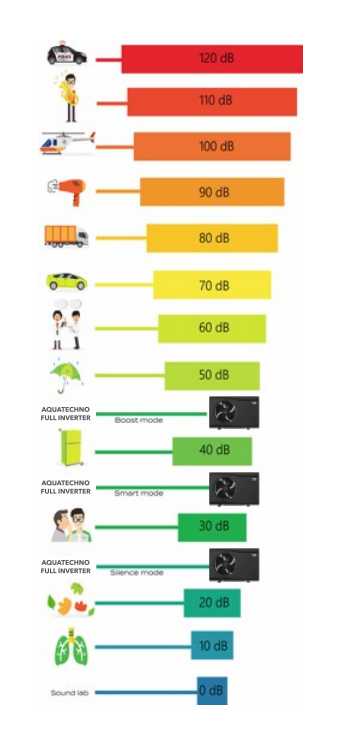
Does a heat pump make a lot of noise?
10 years ago there was a regular problem with the noise nuisance of a heat pump. Neighbors or the municipality could sometimes be difficult about the type and noise level of these devices. The sound of a heat pump was around 70db at 2 - 3m.
Today, this noise problem has been greatly reduced. INVERTER heat pumps work with a frequency controlled fan and compressor. So could with it reduce noise level to 35dB at 2 - 3m distance. Noise nuisance caused by a heat pump for the neighbors when you are sitting at the swimming pool is therefore a thing of the past.
- 25dB in Silence mode
- 35dB in Smart mode
- 45dB in Boost mode
Why a heat pump for heating your swimming pool water?
A heat pump is first and foremost economical, after solar collectors, this is the most economical device to heat your swimming pool water. The heat pump runs very economically, especially in the summer months when there is fairly warm outside air (>15°C).
A high-quality heat pump is equipped with material that can withstand most swimming pool products, such as chlorine and salt water.
The latest new development are the INVERTER HEAT PUMPS. These devices have very strong technical specs. It sound is up to 20dB lower than a standard heat pump and the consumption is lower due to a COP of up to 15.50 or 60% than with the "standard" swimming pool heat pumps.
This way of heating your swimming pool extracts no less than 80% of its energy from the air, which of course makes the return very attractive and quickly earns back the investment.
How do I install a heat pump?
If you want it to work as cost-effectively as possible, a heat pump needs space in the environment. The heating medium repels cold air and absorbs the fresh warm air. If you were to install it in a closed space, it would absorb its own cold air and it would render less well.
We advise you not to place anything around the heat pump within a radius of 50 centimeters from the device.
It is also best to install a heat pump as close as possible to the filter installation.
Below you can see a diagram of how to install a heat pump in relation to your installation:
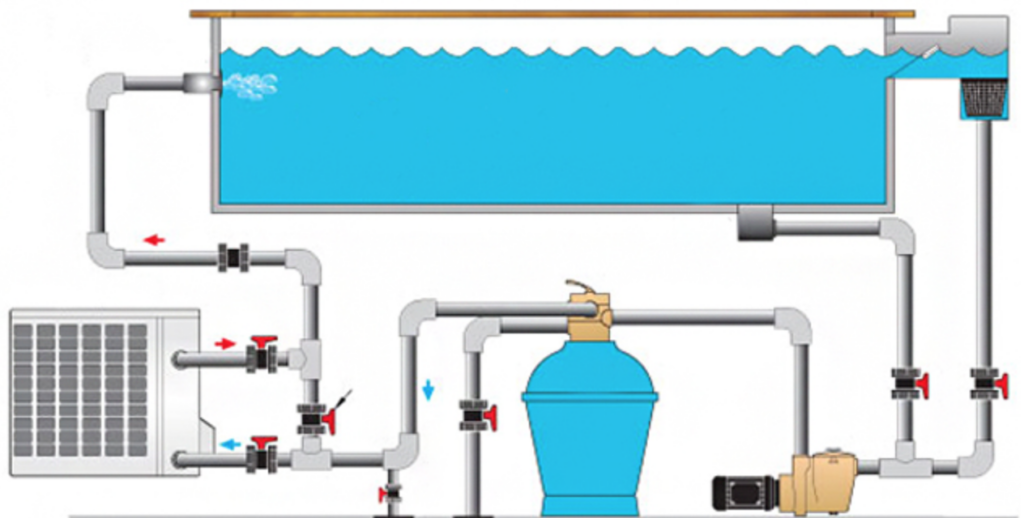
TIP : It is smart to install a heat pump BYPASS to provide. These are 3 PVC ball valves that ensure that you can easily disconnect the heat pump in the winter.
HOW TO SELECT THE RIGHT POOL HEAT PUMP?
- Pool size
- Electricity supply MF or TF
- Space/environment
Tip for wintering your swimming pool heat pump
We recommend that you drain the water in winter and switch off the electricity to the heat pump. This will prevent the pump from freezing to pieces.
Disadvantage of swimming pool heat pumps
Certain heat pumps do not work below 7°C, so you cannot use them for a certain period of the year. The new INVERTER heat pumps already operate at an outside temperature of -15 to -7°C
It takes a few days/hours before the water is up to temperature. It obviously depends on the size of the pool and the outside temperature.
A heat pump can produce quite a bit of noise, which can be very annoying for you or the neighbours. But with the new full inverter heat pump, this problem with a reduced noise production of 20dB is no longer a disadvantage.
Fact about the swimming pool heat pump
Did you know that you can swim energy-efficiently with a heat pump for your swimming pool? April to October in swimming pool water at 28°C.
Service and warranty
You can rely on our expertise to choose a good heat pump. We are happy to give it to you correct advice but also take care of the after-sales service by our technicians or for one installation if you wish.
We work with renowned brands (DURATECH / PROPULSION) and with reliable wholesalers who can guarantee us a good service.
BLOG READING TIP : WINTER POOL HEATING
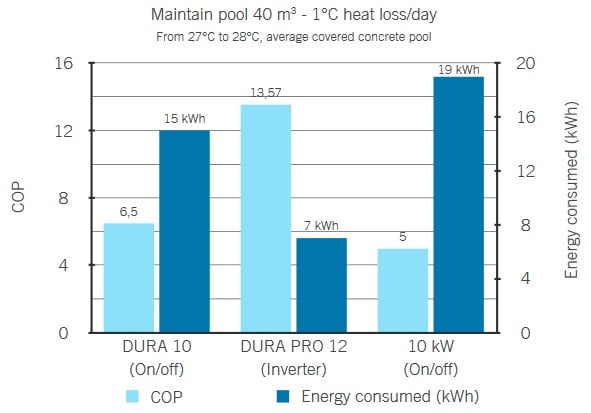
What makes an inverter heat pump so great?
The consumption of an Inverter heat pump is 50 to 60% lower. But above all, the noise level is also lower by up to 20dB. The 2 properties that used to be considered a disadvantage have therefore been completely wiped away. The Dura Pro Inverter and the Vesuvio Full Inverter heat pump are extremely quiet and economical heat pumps for heating your swimming pool water.
The only pool heating that is even more sustainable are the Blozoen Solar collectors.
Can I use a heat pump for any type of swimming pool?
You can use a heat pump for a built-up swimming pool, but also for built-in swimming pools or, for example, indoor swimming pools.
- For above-ground swimming pools, it is best to use a PLUG & PLAY heat pump such as the Sunspring or the Onda mini heater
- For built-in swimming pools and larger volumes of swimming pool water, it is best to choose one INVERTER heat pump. These pool heat pumps are incredibly quiet and economical
- For indoor swimming pools, it is best to choose an ALL SEASON heat pump
Should I choose a vertical or a horizontal heat pump?
The choice for a horizontal or a vertical swimming pool heat pump mainly depends on the space. The smaller models are usually vertical. This means that the cold air is blown upwards. With a horizontal model, the unit blows the cold air out at the front. The vertical heat pumps have a very small efficiency advantage because the surface of the cooling plates is larger.
TIP : Make sure there is plenty of free space around the pool heat pump to keep the device working properly.
How do you protect the heat pump in winter?
Winter is a risk for the heat pumps. Frost damage is usually serious and costly to repair. Make sure that no water remains in the appliance during the winter, tilt the appliance slightly and close the taps. It is best to place a winter cover over the appliance or with the smaller models such as the sunspring heat pump or the Onda mini heater heat pump you can also disconnect it and place it indoors.
At start-up, the device can clean with the Heat pump cleaner. The efficiency of the heat pump depends on the released cooling packages. the purer they are, the better the efficiency.
